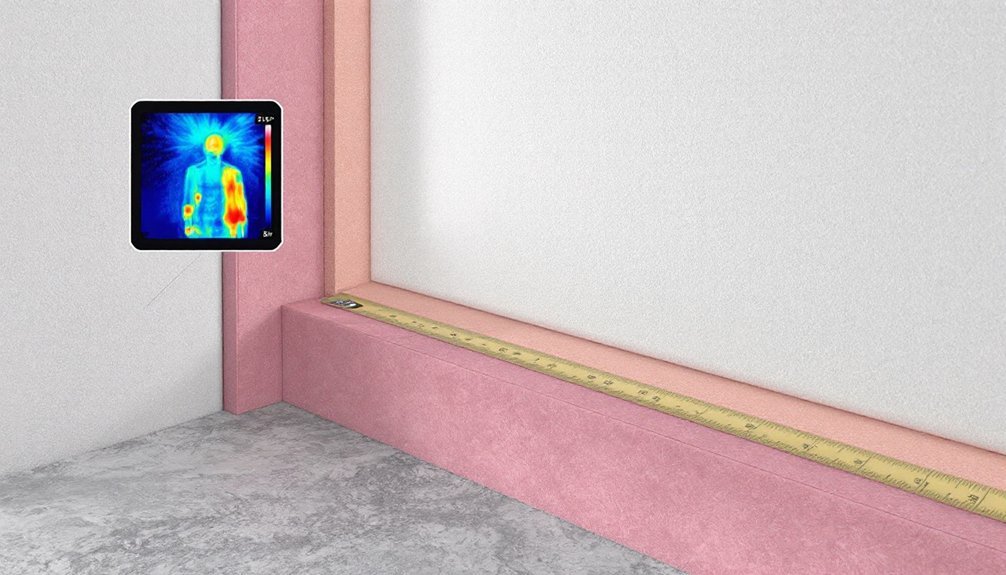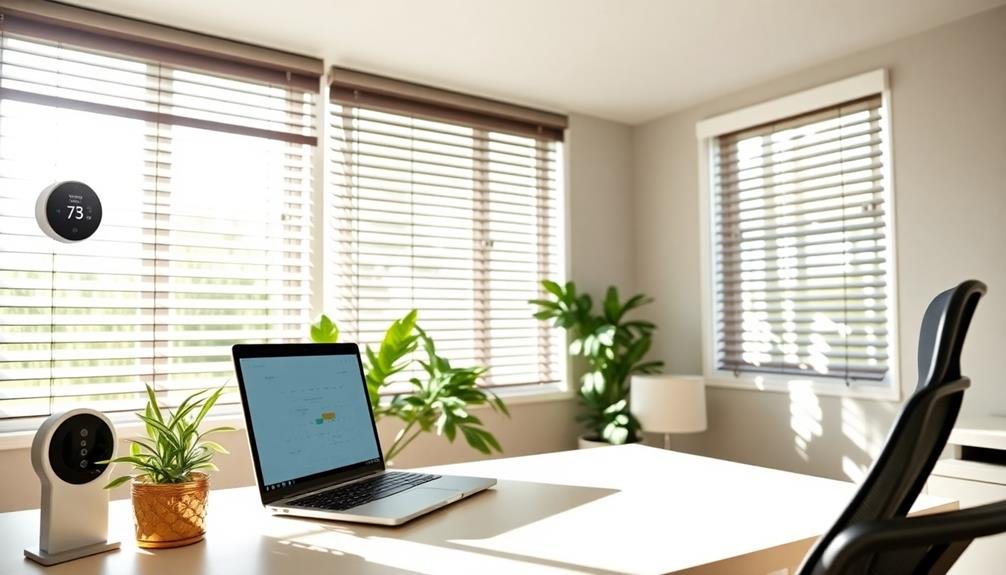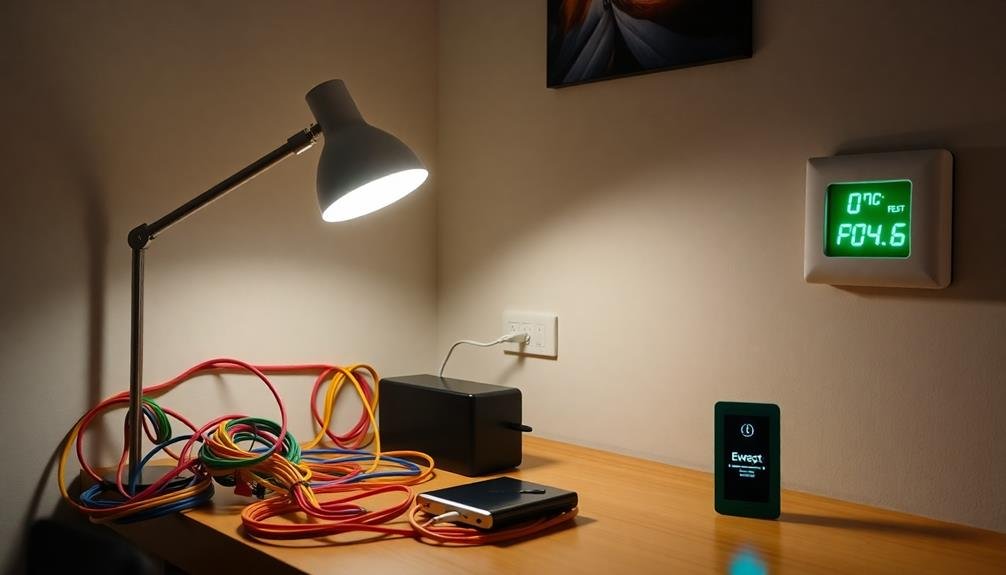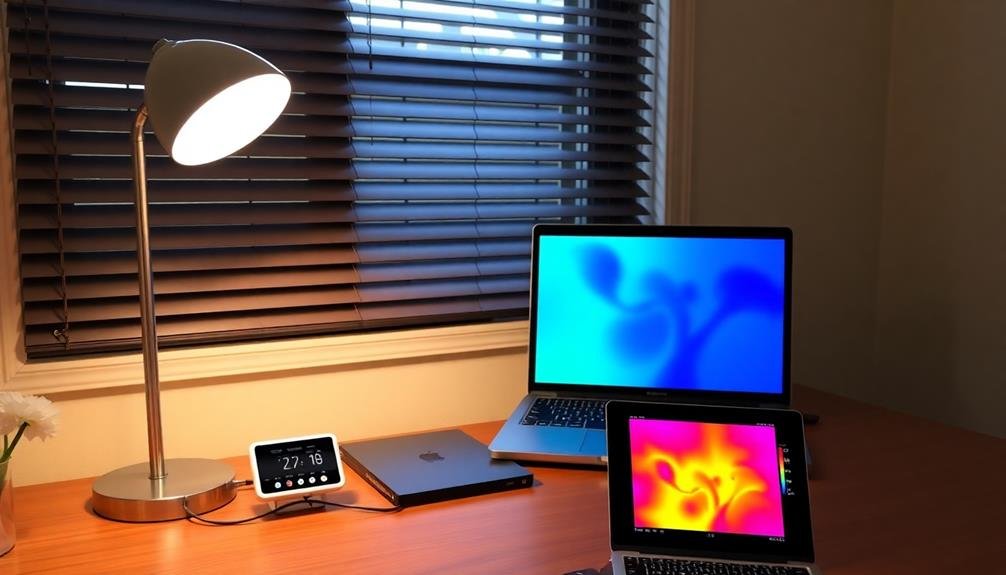When you're looking to maximize your basement's energy efficiency, choosing the right insulation panels can be overwhelming. You'll find countless options on the market, each claiming to be the best solution for your needs. From acoustic foam panels to reflective barriers, the choices in 2025 have evolved considerably, offering improved R-values and innovative installation methods. Let's examine the top 7 basement wall insulation panels that'll help you create a more comfortable space while reducing those energy bills.
Art3dwallpanels Acoustic Panels 10 Pack (Black, Self Adhesive)
Three compelling features make Art3dwallpanels Acoustic Panels ideal for DIY enthusiasts seeking both sound control and aesthetic improvement. You'll appreciate the self-adhesive backing that enables quick peel-and-stick installation without special tools. Each pack includes 10 high-density polyester panels measuring 48x12x0.35 inches, providing substantial coverage for your space.
These panels effectively reduce echoes and absorb high-frequency sound reflections, creating a more balanced acoustic environment. While they won't completely soundproof your basement, they'll greatly dampen noise in recording studios, home theaters, or game rooms. The flame-retardant, odorless material offers durability and safety while doubling as an attractive wall covering that can conceal surface imperfections.
Best For: DIY enthusiasts, content creators, and homeowners looking for an affordable and easy-to-install solution for room acoustics and noise reduction while adding a modern aesthetic touch.
Pros:
- Easy peel-and-stick installation requires no special tools or expertise
- High-density polyester material effectively reduces echoes and absorbs sound
- Flame-retardant, odorless panels double as attractive wall coverings that can hide wall imperfections
Cons:
- Not suitable for complete soundproofing
- Some users report panels may be slightly smaller than advertised dimensions
- Adhesive strength may vary, potentially requiring additional mounting support
50 Pack Acoustic Soundproof Studio Foam Panels
For DIY home recording enthusiasts seeking budget-friendly acoustic treatment, these 50-pack soundproof foam panels offer a practical starting point. Each 12×12-inch panel covers 50 square feet total, helping reduce echoes and reverberations in your basement studio space.
You'll need to plan ahead, as these vacuum-packed panels require 24-48 hours to expand to their full 1-inch thickness. While they're not professional-grade soundproofing, you can enhance their effectiveness by combining them with other acoustic treatments. Mount them using double-sided tape, FlexGlue, or proper mounting hardware, but verify your surfaces are clean first.
Best For: DIY home recording enthusiasts and hobbyists looking for an affordable, entry-level acoustic treatment solution for small studio spaces or practice rooms.
Pros:
- Cost-effective solution covering 50 square feet with 50 panels
- Easy DIY installation with multiple mounting options
- Durable material that's fireproof, fade-resistant, and aging-resistant
Cons:
- 24-48 hour expansion time required before installation
- 1-inch thickness may not provide sufficient sound dampening for professional needs
- May require additional soundproofing products for optimal results
SmartSHIELD Reflective Foam Core Insulation Roll (24x50ft)
DIY enthusiasts and homeowners seeking maximum insulation value will find the SmartSHIELD Reflective Foam Core Insulation Roll an exceptional choice for basement walls. With its impressive R-value of up to 15.67 and 95% radiant energy reflection, this 5mm thick roll delivers superior thermal protection in a single layer.
You'll appreciate the dual functionality of the closed-cell polyethylene foam, featuring reflective foil on one side and white polyethylene film on the other. It's not just an insulator – it also serves as a vapor barrier and sound dampener. The Class 1 fire-rated material comes with a 10-year warranty, and at just 3.49 pounds per roll, you'll find it easy to measure, cut, and install.
Best For: DIY homeowners looking for an all-in-one insulation solution that offers excellent thermal protection, vapor barrier properties, and sound dampening for basement walls and other residential applications.
Pros:
- Exceptional R-value of up to 15.67 and 95% radiant energy reflection in a single layer
- Versatile functionality serving as insulation, vapor barrier, and sound barrier with clean white finish
- Lightweight (3.49 pounds) and easy to install with simple cutting and measuring
Cons:
- Some customers reported receiving damaged rolls
- May not meet length specifications as advertised in some cases
- Higher initial cost compared to traditional insulation materials
Lynn Manufacturing Ceramic Fiber Insulation Blanket (2400F)
Professional contractors and DIY enthusiasts seeking high-temperature insulation solutions will find the Lynn Manufacturing Ceramic Fiber Insulation Blanket an excellent choice. This USA-made product handles extreme temperatures up to 2400°F, making it ideal for specialized basement applications near heating systems and ductwork.
You'll appreciate its versatility with 1" x 12" x 24" dimensions and 8 lb/ft³ density. It's comparable to premium brands like Kaowool and Fiberfrax but often at a better value. The blanket's compressible nature lets you easily fit it into tight spaces while maintaining its insulating properties. Whether you're insulating around furnaces, boilers, or high-temperature pipes in your basement, this ceramic fiber blanket delivers reliable performance.
Best For: Professional contractors, DIY homeowners, and craft enthusiasts working on high-temperature insulation projects requiring reliable heat resistance up to 2400°F in applications like furnaces, kilns, and heating systems.
Pros:
- Superior heat resistance up to 2400°F makes it suitable for extreme temperature applications
- Versatile and easy to work with, can be cut and compressed to fit various spaces
- Made in USA with quality comparable to premium brands but often at better value
Cons:
- Specific installation instructions not provided with product
- May require protective gear during handling due to ceramic fiber composition
- Limited size options with only one standard dimension available (1" x 12" x 24")
DGSL Double Reflective Bubble Foil Insulation (47in x 15ft)
Homeowners seeking versatile insulation solutions will appreciate DGSL's Double Reflective Bubble Foil Insulation, which delivers three key benefits: effective temperature control, easy installation, and broad application potential.
You'll find this 47-inch by 15-foot insulation particularly useful for basement walls, as its double aluminum foil and bubble construction blocks heat transfer while preventing moisture buildup. The lightweight material cuts easily with scissors, and the included 60 self-adhesive pads make installation straightforward. With a proven track record of reducing temperatures by roughly 10 degrees, this 4.5-star-rated product offers excellent value for your basement insulation project.
Best For: Homeowners looking for an affordable and effective insulation solution for basements, garages, RVs, or windows who want easy installation and significant temperature control benefits.
Pros:
- Versatile application across multiple surfaces with proven temperature reduction of about 10 degrees
- Easy installation with included self-adhesive pads and simple cutting with regular scissors
- Durable double aluminum foil construction that effectively blocks heat and provides moisture resistance
Cons:
- May require additional adhesive beyond the included pads for secure installation
- Arrives with packaging creases that can be difficult to smooth out
- Limited size of 47" x 15' may require multiple rolls for larger projects
24 Pack Pyramid Designed Acoustic Foam Panels (12x12x2 Inches)
Sound enthusiasts seeking professional-grade acoustic treatment will find exceptional value in these 24-pack pyramid acoustic foam panels. Each 12x12x2-inch panel features a distinct pyramid design that maximizes sound absorption, effectively reducing echo and reverberation in your basement space.
You'll get 24 square feet of coverage with these high-density panels, which are both flame retardant and non-toxic. While they're ideal for acoustic treatment, be aware that installation can be tricky – you might need alternative mounting methods beyond the provided adhesive. It's essential to let the panels air out for 24 hours before installation to minimize chemical odors.
Best For: Musicians, podcasters, and recording enthusiasts looking to improve sound quality in basement studios or small recording spaces while working within a budget.
Pros:
- High-density 2-inch thick panels provide excellent sound absorption and echo reduction
- Covers 24 square feet with flame-retardant, non-toxic materials
- Versatile pyramid design increases surface area for better acoustic performance
Cons:
- Installation can be challenging as provided adhesive may not stick well
- Chemical odors require 24-hour aeration period before use
- Some users report durability issues and potential difficulty with wall mounting
3009 Garage Door Insulation Kit
Seeking an efficient and cost-effective way to regulate your garage temperature? The 3009 Garage Door Insulation Kit blocks up to 95% of radiant heat with its dual-layer bubble design, achieving an impressive R-21 value.
You'll receive eight pre-cut panels, adhesive tape, and a cleaning sponge for installation. While the process takes about 3 hours with two people, you'll notice immediate results. The kit can reduce garage temperatures by 8-10 degrees in extreme heat and help maintain warmth in cold weather. Consider using Scotch extreme double-sided tape instead of the provided adhesives for better results.
Best For: Homeowners looking to improve their garage's temperature regulation and energy efficiency while maintaining a reasonable budget.
Pros:
- Excellent insulation performance with R-21 value and up to 95% radiant heat blocking
- Complete kit includes pre-cut panels and installation materials
- Helps maintain comfortable temperatures in both hot and cold weather conditions
Cons:
- Installation requires significant time commitment (3+ hours) and ideally two people
- Included adhesives may not be sufficient for long-term panel attachment
- May need additional customization for irregular garage door sizes or frames
Factors to Consider When Choosing Basement Wall Insulation Panels
When you're selecting basement wall insulation panels, you'll need to weigh several critical factors that directly impact your project's success. You should evaluate the material composition and R-value for ideal thermal performance, check moisture resistance ratings to prevent mold growth, and understand the installation requirements for your specific basement setup. The cost per square foot versus coverage area will help you determine the most economical choice while meeting your insulation goals.
Material Type and Composition
The selection of appropriate insulation materials for your basement walls plays an essential role in achieving ideal thermal performance and moisture control. You'll find closed-cell foam insulation, like polyethylene, offers superior R-value per inch and built-in vapor barrier protection, making it particularly effective for damp basement conditions.
While fiberglass insulation provides a budget-friendly alternative with strong thermal resistance properties, you'll need to carefully consider moisture management in your installation plan. The material's density directly impacts both thermal and acoustic performance – denser materials typically deliver better sound dampening capabilities.
When selecting your insulation panels, don't overlook fire safety ratings and certifications. You'll need to verify your chosen material meets local building codes and provides adequate fire protection for your basement space.
R-Value and Thermal Performance
Ideal thermal performance in basement wall insulation starts with understanding R-value requirements. For your basement walls, you'll want to aim for an R-value between 15 and 20 to guarantee peak energy efficiency and comfort. This range provides effective resistance against heat transfer while maintaining stable indoor temperatures.
When selecting insulation panels, don't just focus on the R-value number alone. You'll need to take into account your specific climate zone and building design, as these factors greatly impact thermal performance. Make certain you're also accounting for proper moisture barriers during installation, as dampness can severely compromise your insulation's effectiveness. The density and installation method of your chosen material will affect its real-world performance, so it's vital to follow manufacturer specifications for maximum thermal resistance and energy savings.
Moisture Resistance Properties
Selecting moisture-resistant insulation panels stands as a vital priority for basement walls, where water infiltration poses constant challenges. You'll want to choose materials specifically engineered to combat moisture-related issues that can lead to mold, mildew, and structural deterioration.
Closed-cell foam insulation offers superior protection against water penetration while maintaining its thermal performance. When evaluating options, look for panels that include an integrated vapor barrier – this feature's essential for blocking moisture from seeping through your walls. Confirm your selection meets local building codes for moisture control standards.
You'll also need to verify that your chosen panels are rated for typical basement humidity levels. This rating guarantees long-term effectiveness and helps prevent costly moisture-related problems that could compromise your basement's integrity and your family's health.
Installation Method Requirements
Before committing to specific basement wall insulation panels, you'll need to evaluate several essential installation requirements that can greatly impact your project's success. Consider whether your chosen panels come with self-adhesive backing or require additional fasteners and tools. If you're selecting foam panels, remember they may need up to 48 hours to expand to their full size after unpacking.
You'll want to check if the panels are pre-cut or require custom sizing for your basement walls. Surface preparation is vital – verify your walls are clean and dry before installation begins. Don't skip reviewing the manufacturer's guidelines, as they'll provide specific instructions for proper installation techniques. These requirements will help you determine the complexity of the project and whether you'll need professional assistance.
Cost Vs Coverage Area
After establishing proper installation methods, your next consideration should focus on balancing cost against coverage area. You'll need to calculate your basement's total square footage to determine how many insulation panels you'll require. While some products may have higher upfront costs, they could offer better value through increased coverage area per panel.
Don't just look at the price tag – consider the R-value each panel provides. Higher R-value options might cost more initially but can deliver superior energy efficiency and lower your heating bills over time. As you compare products, check if they include installation kits or necessary accessories. These bundled materials can affect your total project cost and might make a seemingly expensive option more economical when you factor in all the components you'll need.
Fire Safety Ratings
When it comes to basement insulation panels, fire safety ratings should be a top priority in your decision-making process. You'll want to focus on materials that carry a Class A fire rating, as these offer the highest level of protection against flame spread and fire hazards in your basement space.
Look for insulation panels that have been tested and certified by NFPA and UL standards. These organizations evaluate the flame spread index of materials, ensuring they meet strict safety requirements. The higher the fire safety rating, the better protected your basement will be in case of emergency.
Since basements are confined spaces, it's essential to choose panels that won't contribute to rapid fire spread. Selecting materials with superior fire resistance ratings will give you peace of mind and enhance your home's overall safety.
Frequently Asked Questions
How Long Does Basement Wall Insulation Typically Last Before Needing Replacement?
You can expect your basement wall insulation to last 20-30 years before needing replacement, though it'll serve you longer if it's properly installed and protected from moisture damage. Regular inspections help maximize its lifespan.
Can I Install Basement Wall Insulation Panels Myself Without Professional Help?
You can DIY install basement insulation panels, but you'll need basic handyman skills and knowledge of vapor barriers. For best results and to avoid moisture issues, it's safer to consult a professional.
Will Insulating Basement Walls Affect Indoor Air Quality or Humidity Levels?
Yes, insulating your basement walls will impact indoor air quality and humidity. You'll notice reduced dampness and better air quality if you install proper vapor barriers and guarantee adequate ventilation during the installation process.
Do I Need Permits to Install Basement Wall Insulation in My Area?
You'll need to check with your local building department, as permit requirements vary by location. Many areas require permits for basement insulation projects, especially if you're modifying walls or adding vapor barriers.
Can Basement Wall Insulation Help Reduce Noise From Outside the House?
Yes, you'll notice significant noise reduction when you install basement wall insulation. It helps absorb and block outside sounds from entering your home. The thicker and denser the insulation, the better soundproofing you'll get.





Leave a Reply